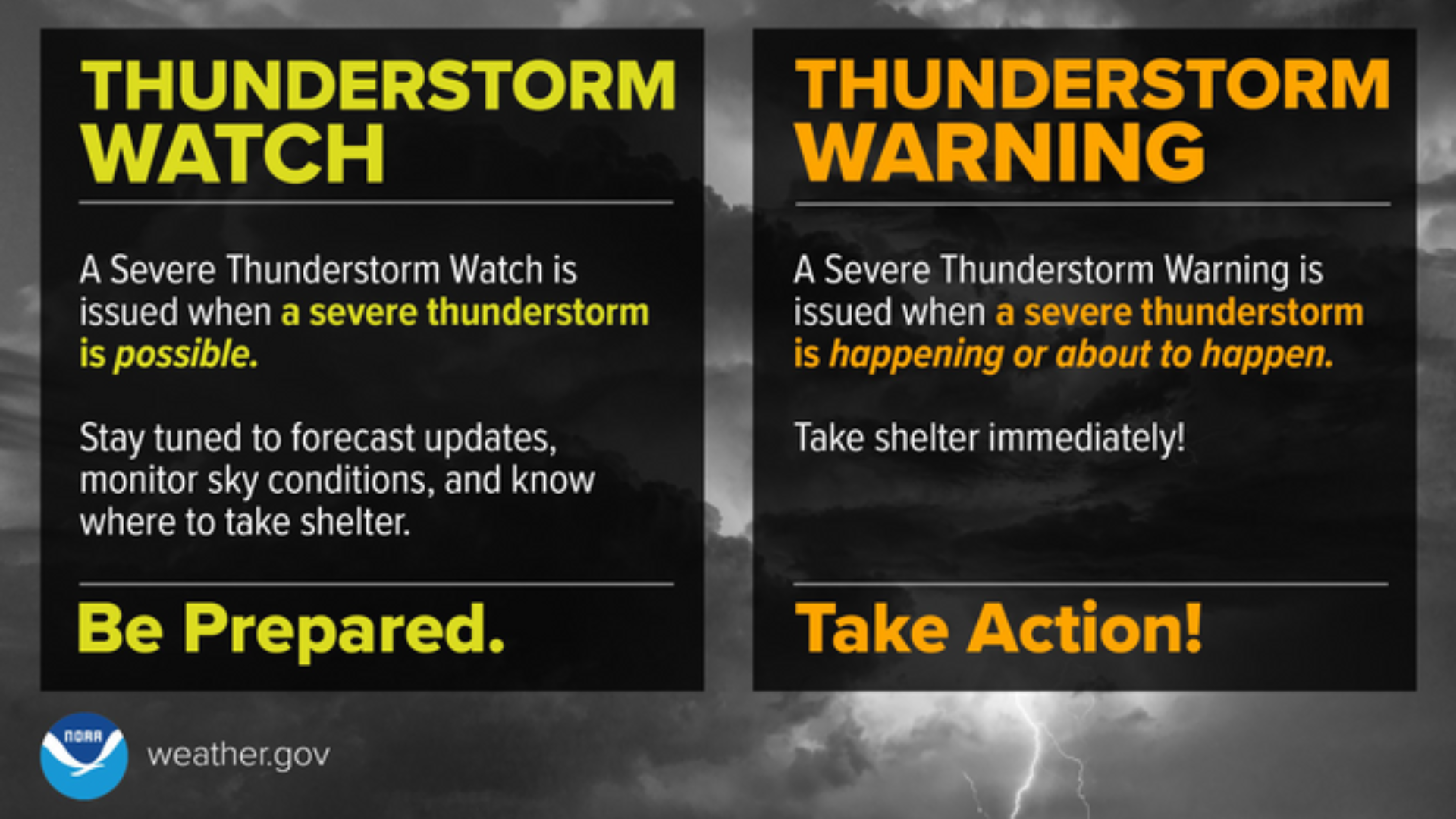
A severe thunderstorm watch is issued by the National Weather Service (NWS) when conditions are favorable for the development of severe thunderstorms in and close to the watch area. It is intended to alert people to the possibility of severe weather so they can be prepared and take precautions. During a severe thunderstorm watch, you should stay informed about the weather and be ready to take action if a warning is issued.
A severe thunderstorm warning is issued by the NWS when a severe thunderstorm has been observed or indicated by radar. This means that severe weather conditions, such as large hail, damaging winds, or tornadoes, are occurring or are imminent in the warned area. When a severe thunderstorm warning is issued, you should take immediate action to protect yourself and your property, such as seeking shelter indoors and avoiding windows.

Severe thunderstorms can present several hazards, including:
- Damaging winds that can cause property damage, down trees, and power lines, and create dangerous flying debris.
- Hail of varying sizes, ranging from small pellets to large stones can cause significant damage to vehicles, crops, and structures.
- Flash flooding in low-lying areas, creeks, and rivers caused by heavy rainfall in a short period.
- Tornadoes can spawn with violently rotating columns of air that can cause widespread destruction and pose a significant threat to life and property.
- Lightning which can strike people and objects, causing injury or fire.
- Hazardous driving conditions including reduced visibility, flooding, and slick roads due to heavy rain and hail.
Before a Storm
To prepare for a thunderstorm, consider taking the following steps:
- Stay updated with weather forecasts and emergency alerts.
- Develop a family emergency plan that outlines what you will do during a thunderstorm and designate a safe area in your home where you can take shelter during a thunderstorm.
- Assemble an emergency kit including essential supplies.
- Secure or bring inside any outdoor furniture, toys, or equipment that could become airborne and pose a hazard during high winds.
- Ensure that your home is properly maintained and can withstand severe weather conditions.
Unplug sensitive electronics and appliances to protect them from power surges caused by lightning strikes or electrical disturbances. - Consider investing in a backup power source, such as a generator, to maintain essential functions during power outages caused by thunderstorms.
- Trim branches that could potentially fall on your home or car during a storm.
- Consider installing storm shutters or boarding up windows to protect them from flying debris.

During a Storm
During a severe thunderstorm, take the following precautions to protect yourself and your property:
- Avoid standing near tall objects such as trees, poles, or towers, as they can attract lightning.
- Seek shelter in a sturdy building and avoid windows, doors, and concrete walls. If possible, stay on the lowest floor of the building. Stay indoors until the storm has passed and it is safe to go outside.
- Do not use electrical appliances, including computers and corded phones, as they can conduct electricity in the event of a lightning strike. Use a cell phone or cordless phone instead of a landline phone, as landlines can conduct electricity.
- Do not use plumbing fixtures or electronics connected to the electrical system during a thunderstorm, as lightning can travel through plumbing and electrical wiring.
- Monitor weather reports and listen for updates on severe weather warnings and watches.

If you are in a car during a severe thunderstorm, take the following precautions:
- If possible, safely pull over to the side of the road and stop your car. Avoid parking under trees or power lines. If hail is present, try pulling under a covered area such as a gas station or parking garage.
- Remain inside your car with the windows rolled up. If hail is present, use blankets or clothing to protect yourself from flying glass in case the windows break.
- Do not touch metal objects inside the car, such as the steering wheel, gear shift, or door handles, as they can conduct electricity in the event of a lightning strike.
- Turn off the engine and put your hazard lights on to alert other drivers.
- If you can safely do so, crouch down in your seat to reduce the risk of being struck by lightning entering through the car's windows.
- Do not drive through flooded areas, as water can be deeper or faster-moving than it appears.
- Stay in your car until the storm has passed and it is safe to continue driving.
- Check for any damage to your vehicle before resuming your journey.

After a Storm
After a severe thunderstorm, take the following steps to ensure your safety and the safety of others:
- Continue to monitor weather reports and listen for updates on any additional severe weather warnings or watches.
- Inspect your home, property, and vehicle for any damage caused by the storm. Look for signs of roof damage, broken windows, and downed power lines.
- Take photos of any damage to your home, property, or vehicle to document the extent of the damage for insurance purposes. Report any significant damage to your home or property to your insurance company as soon as possible.
- Be cautious of hazards such as downed power lines, broken glass, and debris. Avoid walking or driving through flooded areas.
- If you encounter any dangerous situations, such as downed power lines or gas leaks, contact the appropriate authorities immediately.
- Check on your neighbors, especially elderly or vulnerable individuals, to ensure they are safe and offer assistance if needed.
If you experience prolonged power outages, discard the food in your fridge.

